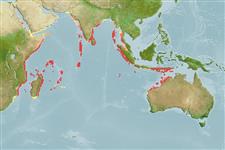>
Blenniiformes (Blennies) >
Blenniidae (Combtooth blennies) > Salariinae
Etymology: Blenniella: Diminutive of blennius, Greek,blenios = mucus (Ref. 45335).
More on author: Bleeker.
Environment: milieu / climate zone / ລະດັບຄວາມເລິກ / distribution range
ນິເວດວິທະຍາ
ສັດທະເລ ກ່ຽວກັນຫີນ. Tropical
Indian Ocean: essentially restricted from African east coast to the west coast of Sumatra, and extending to Java and Bali.
Length at first maturity / ຂະໜາດ / ນ້ຳໜັກ / Age
ການຈະເລີນເຕັມໄວ: Lm ?, range 2 - ? cm
Max length : 8.1 cm SL ຕົວຜູ້/ບໍ່ມີເພດ; (Ref. 9962); 6.0 cm SL (female); common length : 6.0 cm SL ຕົວຜູ້/ບໍ່ມີເພດ; (Ref. 9962); common length :5.5 cm SL (female)
ຄີ (ໜາມ)ແຂງຢູ່ຫຼັງປາ (ທັງໝົດ) : 12 - 14; ຄີຫຼັງຂອງປາ (ຄີອ່ອນ) (ທັງໝົດ) : 19 - 22; ຄີ(ໜາມ) ແຂງຢູ່ຄີກົ້ນປາ
ກຸ່ມປາກະດູກແຂງ
ຄວາມຖີ່ຂອງກຸ່ມຖ່າຍທອດພັນ
ປາທີ່ມີການເຄື່ອນຍ້າຍຈາກທະເລໄປຫານ້ຳຈືດ ແລະນ້ຳຈືດຫາທະເລ
ປາທີ່ມີການເຄື່ອນຍ້າຍຈາກທະເລແລະໄປໄຂ່ຢູ່ນ້ຳຈືດ
ຄີກົ້ນຂອງປາ
ສັດທີ່ມີກະດູກສັນຫັຼງ
ການຖ່າຍທອດທາງກຳມະພັນຈາກພໍ່ແມ່ຫາລູກ: 2; ຄີກົ້ນຂອງປາ: 19 - 22; ສັດທີ່ມີກະດູກສັນຫຼັງ: 38 - 40. Diagnosis: Dorsal fin XII to XIV, 19 to 22, notched between spinous and segmented-ray portions; anal fin II, 19-22; pectoral rays 13-15 (usually 14); pelvic fin I, 3; caudal fin procurrent rays 10-14, segmented rays 13. Vertebrae 11-12 + 27-29. Last pleural rib on 12-13th vertebrae. Orbital cirrus simple filamentous; nasal cirri short and simple to palmate with 2-6 branches; nape without cirri. Lateral line, continuous anterodorsally below dorsal spine 6-7th to 9-10th, disconnected posteroventrally up to below dorsal spine 12-13th. Mandibular pores 4-6. Lips margin entire. Occipital crest present, higher in males (Ref. 9962). Body depth at anal-fin origin 5.6-6.1 in SL (Ref. 90102). Males with dusky bands on body, each band with a vertical pair of oblong spots; dark spot behind eye and opercle (Ref. 4404). Females with faintly dusky bands on body overlain by dark lines that break up into dashes at posterior portion; dark spots on median fins (Ref. 4404).
Body shape (shape guide): elongated.
Oviparous. Eggs are demersal and adhesive (Ref. 205), and are attached to the substrate via a filamentous, adhesive pad or pedestal (Ref. 94114). Larvae are planktonic, often found in shallow, coastal waters (Ref. 94114). Common length: females usually less than 5.5 cm, males usually more than 6.0 cm in SL (Ref. 9962).
Life cycle and mating behavior
ການຈະເລີນເຕັມໄວ | ການສືບພັນ | ການວາງໄຂ່ | ໄຂ່ | ຄວາມດົກຂອງໄຂ່ປາ | ຕົວອ່ອນ
Oviparous, distinct pairing (Ref. 205).
Springer, V.G. and J.T. Williams, 1994. The Indo-West Pacific blenniid fish genus Istiblennius reappraised: a revision of Istiblennius, Blenniella, and Paralticus, new genus. Smithson. Contrib. Zool. 565:1-193. (Ref. 9962)
IUCN Red List Status (Ref. 130435: Version 2025-1)
Threat to humans
Harmless
Human uses
ເຄື່ອງມື
Special reports
Download XML
ແຫຼ່ງອີນເຕີເນັດ
Estimates based on models
Preferred temperature (ເອກະສານອ້າງອີງ
123201): 25.9 - 29.3, mean 28.2 °C (based on 721 cells).
Phylogenetic diversity index (ເອກະສານອ້າງອີງ
82804): PD
50 = 0.5020 [Uniqueness, from 0.5 = low to 2.0 = high].
Bayesian length-weight: a=0.00776 (0.00356 - 0.01695), b=3.00 (2.81 - 3.19), in cm total length, based on LWR estimates for this (Sub)family-body shape (Ref.
93245).
ຊັ້ນເຂດຮ້ອນ (ເອກະສານອ້າງອີງ
69278): 2.8 ±0.3 se; based on size and trophs of closest relatives
ຄວາມຢືດຢຸ່ນ (ເອກະສານອ້າງອີງ
120179): ສູງ, ປະຊາກອນຕຳ່ສຸດທີ່ໃຊ້ເວລາສອງໜ້ອຍກວ່າ 15 ເດືອນ (Preliminary K or Fecundity.).
Fishing Vulnerability (Ref.
59153): Low vulnerability (10 of 100).
🛈
